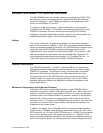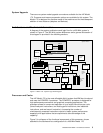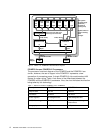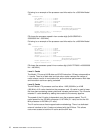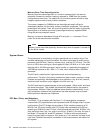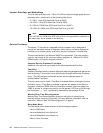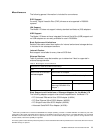RS/6000 7044 Model 170 Technical Overview 5
Copper and CMOS Technology
The use of copper in chip design addresses several or the aspects that inhibit
performance: power load, generated heat, clock signal distribution, and chip size.
The complexity of the chip design (roughly equated to the number of transistors)
when combined with the lithography process determines the size of the die. The
maze of interconnects between the circuitry over a large die, the voltage required
to drive the circuits, and the clock speed of the chip (how often a circuit changes
state) determines the power load and the heat generated. Heat affects the life of
the chip. Specific areas of a chip, for example, an execution unit, can become
hotter than other areas that operate less frequently and require extensive cooling.
Also, the larger the chip, the more difficult it is to strobe a clock signal over the
entire chip (electricity travels at the fixed speed of light). Because larger chips
also require more area on a wafer, they are more expensive to produce.
Copper is a superior conductor of electricity, compared with the standard
aluminum used previously. This equates to lower electrical resistance (40 percent
less) and allows a smaller wire (interconnects) to handle the same electrical load.
The smaller interconnects within the chip decrease the distance between
components, reduce the heat generated, and decrease the clock skew over the
chip making it possible to raise the clock speed without affecting reliability. This is
particularly useful on the POWER3-II which is an advanced and complex chip
with twice the number of transistors as in a Pentium II.
However, copper does not work well with silicon, the base material of
semiconductor chips. If copper is put directly on silicon, copper atoms migrate
into the silicon, making it virtually useless. IBM researchers found a way to put a
microscopic barrier between the copper and silicon in a way that keeps the
copper from contaminating the silicon, while actually reduces the number of steps
needed to complete a chip. With this development, IBM is able to reduce the
widths of copper wires to about 0.2-microns from the current 0.35-micron width -
a feat far more difficult to achieve with aluminum.
This technology, called CMOS 7S, is the first to use copper instead of aluminum
to create the circuitry on silicon wafers. This translates into an increased speed of
up to 15 percent in processors that contain copper wires.
CPU Clock Rate
The different processor cards and the processor speeds can be identified by the
SMS Display Configuration menu or by the following AIX command:
lscfg -vp | more
Page down to the Processor Card entry and search for the Product Specification
(ZC) entry. This gives detailed information about:
PS Processor Clock Speed in Hz, ASCII coded hexadecimal
LB L2 Bus Speed in Hz, ASCII coded hexadecimal
SB System Bus Speed in Hz, ASCII coded hexadecimal
NP Number of Processors on Card, ASCII coded hexadecimal
L2 L2 Size in number of Kilobytes, ASCII coded hexadecimal





